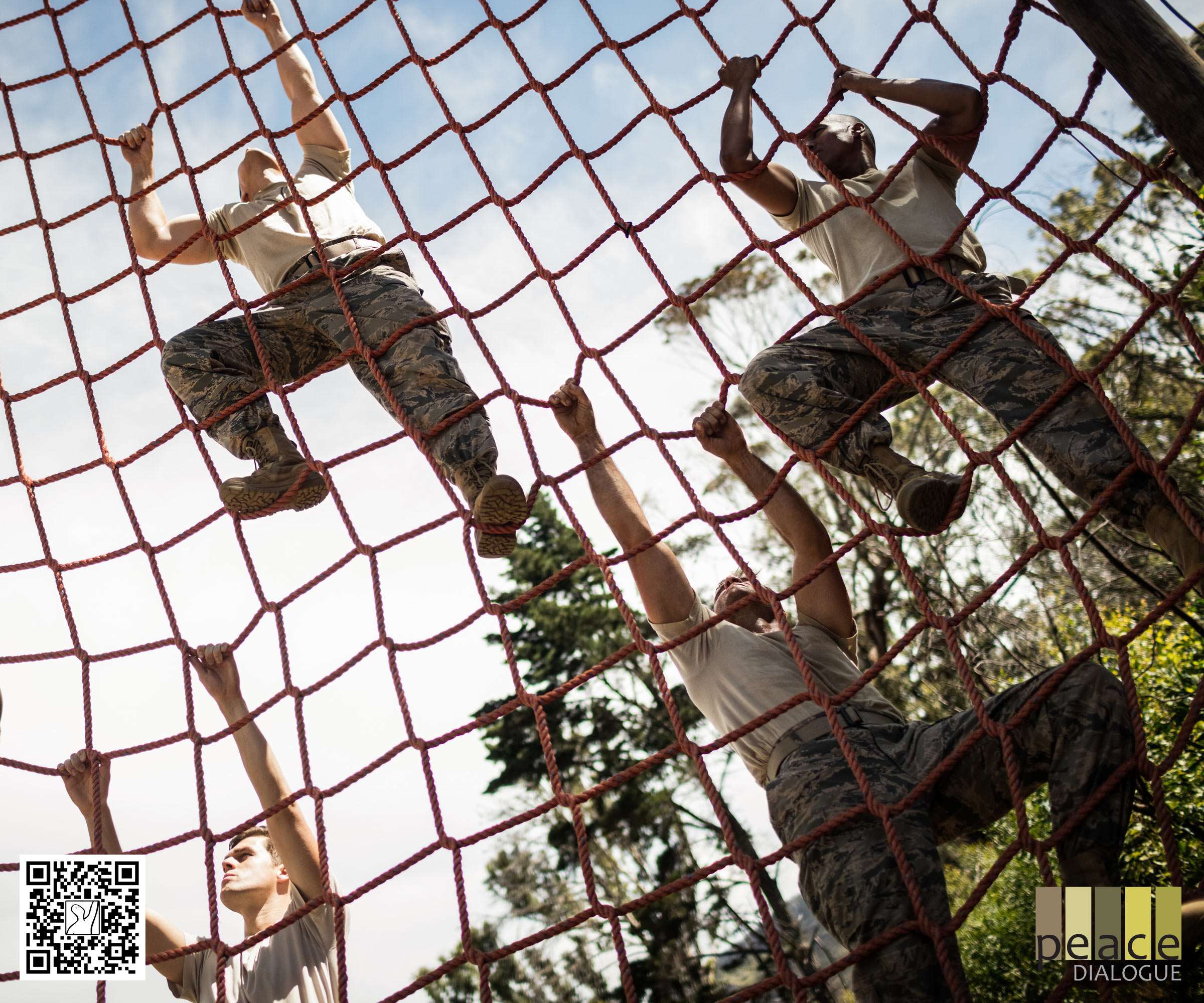
© 2024. IMAGE SOURCE: ISTOCK
INTRODUCTION
For over a decade, Peace Dialogue NGO has been dedicated to enhancing Human Rights conditions within the Armenian Armed Forces. Since 2015, the organization’s monitoring group has been diligently assessing and monitoring human rights conditions in the military. During the period from July to September 2023, Peace Dialogue’s monitoring group conducted a series of surveys. These surveys targeted individuals who had taken part in military training sessions at various intervals, with the goal of gathering comprehensive insights into the human rights conditions experienced during these training sessions.
METHODOLOGY
The survey encompassed a wide geographic scope, covering Yerevan and nearly all Armenian regions, with the notable exceptions of Aragatsotn and Armavir regions. A carefully designed methodology underpinned the survey process, which included both face-to-face interviews and telephone interactions, facilitated through pre-structured questionnaires.
SURVEY PARTICIPANTS
The 45 survey participants were selected from a wide range of regions, cities, and villages throughout Armenia. These respondents have a military service history spanning from 1996 to 2021, encompassing various military units in both Armenia and Nagorno-Karabakh. Most of the participants underwent military training exercises in 2023, while three respondents participated in 2022, two in 2021.
NOTIFICATION AND DRAFTING PROCESS
The survey shed light on the various methods used to notify participants about their military training. A notable majority, 65% or 29 individuals, were informed through official notices. Other common methods of communication included phone calls, accounting for 19% or 8 individuals, and notifications from local government bodies, representing 14% or 6 individuals. Additionally, there was a single instance (2%) where an individual received information through their workplace.
Fig. 1 Methods of Notification for Military Trainings
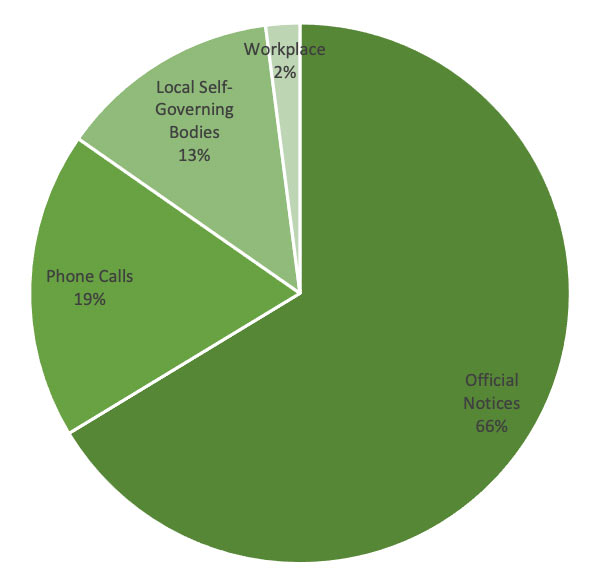
Concerning the duration between receiving the draft notice and actual conscription, the survey revealed that the longest waiting period spanned one month, while the shortest reported interval was a mere 2 days, denoting the minimum timeframe encountered by the respondents.
“Went to the military commissariat a day after the notice, and left the next day” (Gyumri, Shirak Region, Participant of the Military Training in October, 2022)
“We were sent to medical examination after visiting the military commissariat, and 3 days later were called to military commissariat” (Margahoivit vil. Lori region, Participant of the Military Training in April, 2023)
“Ww were told to wait for their call, 15 days later were taken to military commissariat” (Lernapat vil., Lori Region, Participant of the Military Training in March, 2023)
PRE-TRAINING MEDICAL EXAMINATION
A significant 89% of respondents (40 individuals) underwent medical examinations prior to commencing their training, while 11% (5 respondents) did not undergo any form of medical examination.
Out of the 40 respondents, 10 (25%) underwent their medical examinations exclusively at military commissariats, while the remaining individuals were directed to undergo more comprehensive examinations at hospitals and polyclinics. Among the mentioned 40 respondents, 5 indicated they had undergone a meticulous medical examination, 7 described their examination as superficial, and 2 reported finding the examination satisfactory. The remaining participants did not provide comments on this aspect of their experience.
“It hardly resembled a medical checkup – they barely gave the lungs a listen at the polyclinic” (Kapan, Syunik region, Participant of the Military Training in August, 2023)
“I went to the hospital consulted a specialist at my own expense.” (Gyumri, Shirak region, Participant of the Military Training in April, 2023)
“At the military commissariat, I was directed to the Vanadzor Medical Center and provided with a medical reference for submission there. After I reported having no health issues, the staff at the Medical Center filled out the form and handed it back to me” (Lernapat, Lori region, Participant of the Military Training in March, 2023)
TRAINING CONTENT AND PROFESSIONAL RELEVANCE
A large number of survey participants, 98% or 44 individuals, shared that their military training regularly covered important topics like weapon handling, following the Disciplinary Code of the Armed Forces, and learning other skills and knowledge. On the other hand, only one participant (2%) mentioned that they didn’t receive such regular reminders.
Six respondents provided detailed insights into their training. One of them talked about a strict training schedule that included two hours every day focusing deeply on learning weapon handling rules. This training was especially helpful for those who were not familiar with different types of weapons.
Another respondent described a special 10-day training program they attended, which included practice in shooting.
Interestingly, one person said that they didn’t need this type of training.
Additionally, two other respondents mentioned that they started their military service with initial training, which helped prepare them before they moved to their military positions (military duty).
One respondent made an important observation, noting that even without regular reminders in training, the experiences of being in a war made sure they never forgot certain skills and knowledge.
As for the length of the military training, the participants said that, on average, it lasted between 21 to 30 days. However, the time given to developing professional skills varied, ranging from just 1 day to 15 days. This means that in some cases, there was only a day or two focused on developing professional skills.
The survey results indicate that for almost half of the participants (22 out of 45), the profession they had acquired during their compulsory service was acknowledged and incorporated into their training. However, for the remaining participants, their professional background was not considered during the training.
LIVING CONDITIONS DURING TRAINING
The participants in the military training offered insights on their accommodation conditions, focusing on aspects such as sanitation and water availability. Among the 45 respondents, the feedback varied: 5 participants (11%) rated their accommodations as very good, 7 (16%) found them to be good, 23 (51%) deemed the conditions satisfactory, 6 (13%) considered them poor, and 3 (7%) described them as very poor. Notably, one respondent chose not to answer the question regarding accommodation conditions.
Fig. 2 Participants’ Opinion on the Accommodation
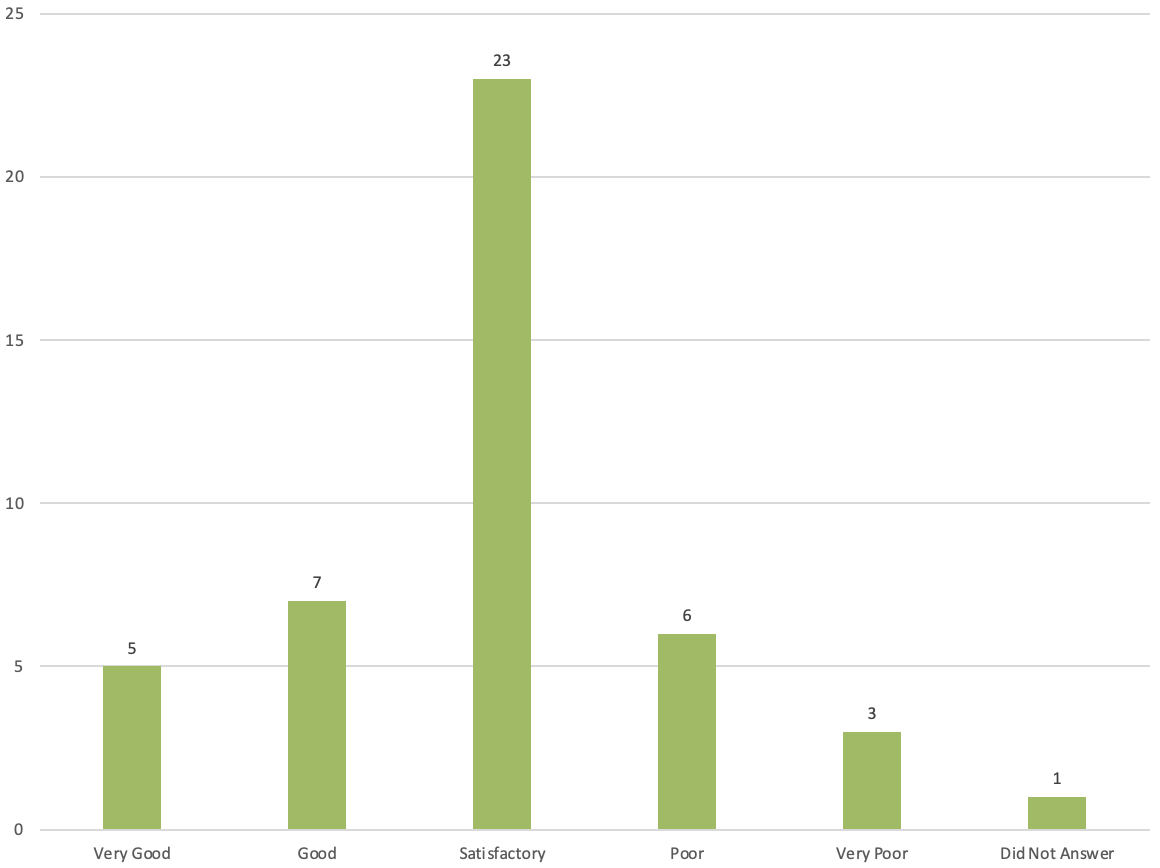
“While the conditions were very good within the military unit itself, the sanitation at the military positions was poor. We spent the nights in dilapidated tents. We went without washing and had no water except for drinking for 10 days.” (Kapan, Syunik region, Participant of the Military Training in September, 2023)
“The accommodations were damp and cold, but thankfully there was water. Considering the large number of men in one place and the absence of cleaning staff, the sanitary conditions couldn’t have been good.” (Kapan, Syunik region, Participant of the Military Training in September, 2023)
“I am very satisfied with the accommodation I had; everything was good in terms of both comfort and sanitation.” (Yerevan, Participant of the Military Training in May, 2023)
In regard to the arrangement of combat positions, feedback from the interviewees revealed that several locations were deficient in adequate sleeping facilities considering the number of soldiers accommodated. This deficiency necessitated a rotation system for sleeping, leading to insufficient rest for many participants. Furthermore, certain positions, despite recent updates, were found to have substandard toilet and washing facilities. The trainees frequently undertook the task of furnishing these areas themselves. One particular respondent highlighted their reliance on sleeping bags. Alongside these challenges, there were positive aspects such as the availability of stone structures for lodging, the introduction of a new bunker system, and various positions being equipped with necessary furniture. Continuous efforts were underway to improve the overall furnishing and conditions of these areas.
“The conditions were poor; there weren’t enough beds for everyone, and the space was intended for fewer people than were housed there, making it difficult for us to rest properly.” (Lernapat, Lori region, Participant of the Military Training in April, 2023)
The feedback on the food provided during the military training musters was predominantly positive:
- A third of the respondents, 15 people (33%), praised the food as very good and tasty.
- 9 participants (20%) found the food to be fine and were pleased with it.
- 4 respondents (9%) noted that there was an abundance of food, to the extent that there were leftovers.
- 2 individuals (5%) mentioned the flexibility to prepare preferred dishes themselves.
- However, 11 participants (24%) expressed less satisfaction with the food quality.
- A specific concern was raised by 3 people (7%) regarding the poor quality of food at combat positions, leading them to bring their own food.
- The dry or canned food provided in combat positions was met with negative reactions, with one respondent even attributing a stomach ache to it.
Overall, while the majority of respondents had a positive view of the food, some issues were noted, particularly regarding the quality and type of food in combat positions during their military duty.
“The food quality in the military unit was satisfactory; however, the situation differed in combat positions where the provided food primarily consisted of canned dry items. Personally, I experienced stomach pains after consuming this type of food. It was a common practice for many individuals to purchase and bring their own food to these combat positions, bearing the cost themselves.” (Kapan, Syunik region, Participant of the Military Training in September, 2023).
MILITARY DISCIPLINE DURING THE TRAININGS
The monitoring group conducted inquiries with the training participants about their daily schedule. The majority of respondents indicated that their activities followed a specific, pre-determined agenda. While some participants reported being fully occupied throughout the day, others found they had periods with little to do. The organization of the daily agenda varied, with some describing it as well-structured, whereas others perceived it as disorganized, leading participants to plan their activities independently. However, in combat positions, a more structured agenda was typically observed.
The participants shared diverse experiences about their daily routines during the training:
“Our day typically started with lessons, after which we mostly had free time.” (Yerevan, Participant of the Military Training in August, 2023)
“The schedule was very disciplined, resembling a true military agenda. Everything, from lessons to meals, was timely, with no delays whatsoever.” (Berd, Tavush region, Participant of the Military Training in June, 2023)
“Our routine involved holding combat positions for 4 hours followed by 4 hours of rest. This pattern meant that we completed three shifts every 24 hours.” (Kapan, Syunik region, Participant of the Military Training in September, 2023)
The monitoring group conducted an inquiry into the use of alcohol and drugs among participants and officers during training musters:
When asked about their fellow participants, 67% of the respondents (30 individuals) indicated that there was no usage of alcohol or drugs, giving positive responses. On the other hand, 33% (15 individuals) gave negative responses, implying the usage of these substances among peers.
In regards to the officers, a substantial majority (80%, or 36 people) reported that the officers did not partake in alcohol or drug use. Nonetheless, a smaller group (13%, or 6 people) noted instances of both alcohol and drug consumption by some officers.
“Alcohol was only used in the evenings.” (Kapan, Syunik region, Participant of the Military Training in September, 2023)
“People drank alcohol, and almost everyone joined in. I don’t think drugs were used; I didn’t see any.” (Vedi, Ararat region, Participant of the Military Training in June, 2023)
Concerning the use of alcohol or drugs by officers, most respondents indicated they were not aware of such conduct. A sense of strong community was emphasized, particularly during celebrations where alcohol was consumed. The atmosphere was characterized as familial, with everyone treated equally, irrespective of age or rank, contributing to a collective effort to pass the time more quickly. Additionally, one respondent confessed that alcohol was widely used by everyone, themselves included.
When asked about smartphone usage during military trainings, the participants’ responses varied. Of those, 13 respondents (29%) confirmed they were allowed to carry smartphones, while a larger group of 31 respondents (69%) reported that carrying smartphones was prohibited. One individual did not respond to this query. The participants further explained that filming or taking photos for social media posting was not permitted. Interestingly, 4 respondents (9%) indicated that despite the prohibition, they still used their smartphones. One participant was unsure about the policy but acknowledged having a smartphone. Another noted that the absence of phones could have led to more conflicts due to boredom.
The survey revealed that the majority of the participants in the military trainings, comprising 38 individuals or 84%, reported that civilian access to the military unit’s premises was prohibited. However, 7 participants (16%) stated that civilians were allowed entry. Among these, some respondents shared that friends, acquaintances, and family members visited soldiers within the unit on designated visiting days or the day before deployment to combat positions, occasionally bringing necessary items. They also pointed out that, in some instances, soldiers would leave the unit to meet relatives or friends outside. It’s worth noting that only one participant mentioned that visits within the unit were quite common, and another stressed the strictness surrounding such visits in their military unit.
HEALTHCARE AND CONFLICT MANAGEMENT
Out of the 45 survey respondents, 37 individuals affirmed that their military units provided satisfactory medical care in the event of health issues. On the other hand, 7 participants expressed dissatisfaction with the medical care within their military units. It’s worth noting that one respondent opted not to answer the question.
Several respondents provided comments on the healthcare conditions within military units and combat positions:
“Even when we were feeling well, a mobile medical car would visit every few days to check on us and inquire about our health.” (Lernapat, Lori region, Participant of the Military Training in April, 2023)
“One of the trainees had a health problem, a call for help was made, however he was informed that they could not cut so much distance for that issue, the combat position was too far away.” (Kapan, Syunik region, Participant of the Military Training in September, 2023)
“The medical supplies were limited to basic items, consisting only of paracetamol and a few bandages.” (Kapan, Syunik region, Participant of the Military Training in September, 2023)
To gain a comprehensive understanding of the atmosphere during military trainings, the monitoring group investigated the occurrence of arguments or fights among participants. A substantial majority, comprising 35 participants (78%), reported that there had never been any instances of disputes or fights during the training. In contrast, 10 respondents (22%) acknowledged that such incidents occurred occasionally.
Five respondents clarified that predominantly minor arguments had occurred, while two participants described the atmosphere as genuinely friendly, resembling a family. Another respondent emphasized the reality of being grown-up men, acknowledging that occasional misunderstandings were inevitable, thus not ruling out the possibility of disputes or even fights.
Regarding the primary reasons for disputes, participants highlighted misunderstandings among men, commonly referred to as “male disputes.” These issues were typically resolved through discussion. Occasionally, especially during the initial days, minor arguments, disputes, and misunderstandings could occur. Additionally, there were instances of disagreements arising from discussions about politics.
When questioned about fatalities or injuries occurring during training in combat positions, 42 participants (93%) stated that such incidents never occurred. A respondent reported a solitary injury case without offering any comments on the incident’s details. Meanwhile, 2 participants chose not to provide a response to the question.
EQUIPMENT AND AMMUNITION
In response to inquiries about potential malfunctions or shortages of weapons and military equipment during trainings, the majority of respondents, 40 people, stated that they never experienced any issues of this nature. Conversely, 5 participants reported facing problems related to weapon malfunctions or shortages. Some respondents highlighted having sufficient weapons for everyone in the unit. On the contrary, others expressed a shortage of weapons, bullets, and additional equipment. One individual mentioned they lacked the opportunity to use it for assessing the condition of the equipment.
“All our equipment was new and recently received.” (Vanadzor, Lori region, Participant of the Military Training in April, 2023)
“Night vision devices were absent, and there was a limited supply of armored vests and helmets.” (Gyumri, Shirak region, Participant of the Military Training in October, 2022)
“Everything was available, as long as there was someone who knew how to use it.” (Berd, Tavush region, Participant of the Military Training in June, 2023)
“There was a shortage of functioning vehicles, with only one UAZ available, and it wasn’t even in proper working condition.” (Margahovit, Lori region, Participant of the Military Training in April, 2023)
EMPLOYMENT STATUS AND FINANCIAL IMPACT
Out of the 45 participants, 29 individuals (65%) were employed when they attended military training, 11 participants (24%) were not registered employees, and 5 people (11%) were unemployed at that time.
Fig. 3 Employment Status of Military Training Participants
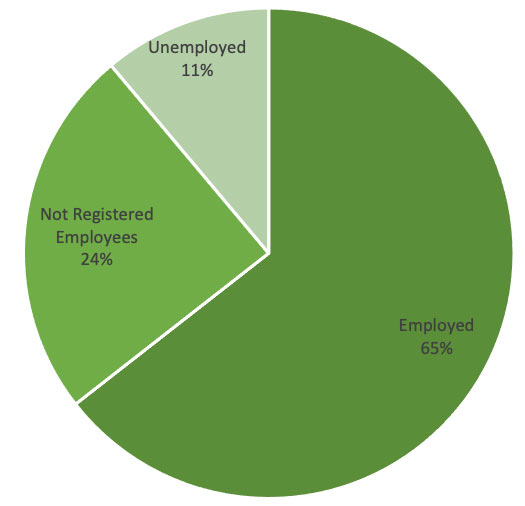
The 32 respondents who were employed during the military trainings, were asked about the provision of a reference to be submitted to their workplace. The majority, comprising 25 participants (78%), confirmed receiving such a reference, while 7 participants (22%) did not. Notably, the reference was accepted in nearly all workplaces, with the exception of one participant’s workplace.
The majority of participants, comprising 39 individuals (87%), received payment during the military trainings, while 6 participants (13%) did not receive compensation. All six participants who mentioned not receiving payment during the military trainings stated that they expected to receive payment in the near future, as they had just returned from the training.
When queried about incurring financial losses during the military training, 18 participants (40%) of the trainings acknowledged experiencing financial setbacks due to their participation, while 27 individuals (60%) reported not incurring such losses. Those who believed they experienced financial losses due to the training pointed out that their side hustles, which were not compensated during the military trainings, played a big role on their finances. Some noted they could have earned more, since the reimbursement was less than their regular salary. One respondent mentioned receiving more money than their typical salary for participating in the trainings.
“The amount they provided was lower than my regular salary; initially, they mentioned a different figure, but ended up giving something else.” (Lernapat, Lori region, Participant of the Military Training in April, 2023)
“Considering I also had unregistered income, naturally, my family was deprived of those resources.” (Gyumri, Shirak region, Participant of the Military Training in October, 2022)
PERCEPTIONS ON THE OVERALL EFFECTIVENESS OF THE MILITARY TRAININGS
The respondents assessed the positive aspects of the military trainings, including their effectiveness, the professionalism of the military staff engaged in the trainings, and their own professionalism post-training. In response to inquiries about their assessment of the overall effectiveness of the military trainings, 19 respondents (42%) regarded it as good, another 19 respondents (42%) as average, and 7 individuals (16%) characterized it as bad. A few individuals shared their thoughts:
“It was bad because, in reality, it wasn’t the training I had imagined. People came there to drink and for money. God forbid if something happened; they wouldn’t have stayed alive.” (Kapan, Syunik region, Participant of the Military Training in April, 2023)
“Moderate; they provided as much instruction as possible, and it was up to individuals to extract the most from it.” (Gyumri, Shirak region, Participant of the Military Training in October, 2022)
“It proved effective; I believe the trainings were well-organized.” (Yerevan, Participant of the Military Training in May, 2023)
When questioned about the professionalism of the military staff in the trainings, the opinions varied. A total of 17 participants (38%) regarded the military staff as professionals in their job. Conversely, another 17 participants (38%) perceived a lack of professionalism. Additionally, 4 participants (9%) noted that most of the staff were professionals, though not everyone. A smaller cohort of 2 participants (4%) rated the professionalism as average. Lastly, 5 people (11%) found it challenging to provide a definitive answer to the question.
Fig. 4 Participants’ Opinions on Military Staff Professionalism
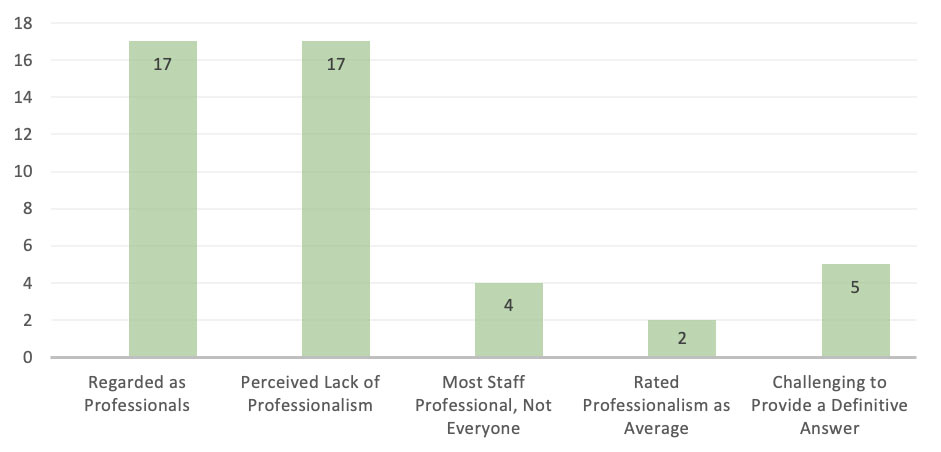
“No, they lacked professionalism. There was even one individual who saw a machine gun for the first time.” (Gyumri, Shirak region, Participant of the Military Training in September, 2021)
“The staff consisted of retired officers, demonstrating an adequate level of professionalism, with some of them being notably excellent.” (Mayisyan, Shirak region, Participant of the Military Training in September, 2023)
The monitoring group asked participants about whether the military trainings adequately prepared them for potential real-life situations. Out of the respondents, 20 individuals (44%) believed that the trainings adequately prepared them for possible war or combat scenarios. Conversely, 13 participants (29%) expressed that the training did not prepare them for real situations at all, while 6 people (13%) reported feeling prepared to some extent. Additionally, 4 individuals (9%) felt ready for all possible real situations, even without the military trainings, and 2 people (5%) were uncertain about whether the training had adequately prepared them for such situations.
“I witnessed actual scenarios during the war, and it did not prepare for a single real-life situation.” (Kapan, Syunik region, Participant of the Military Training in September, 2023)
“Not entirely; it’s insufficient for modern warfare. Conventional weapons aren’t adequate for countering UAVs.” (Gyumri, Shirak region, Participant of the Military Training in October, 2022)
The respondents were also asked to assess the positive aspects of the military trainings. Among them, 30 participants (67%) considered the training positive in terms of revising existing knowledge and acquiring new insights. On the contrary, 8 military training participants (18%) did not perceive any positive aspects. Additionally, 6 people (13%) identified the defense of borders and protection of the motherland as the sole positive aspect of the training. Lastly, one participant (2%) acknowledged the positive impact of the training in instilling a bit more discipline in the army.
When asked whether they would like to participate in another military training and why, the responses varied. The majority of the respondents, comprising 17 participants (38%), expressed that they would not partake in military trainings again. On the contrary, 15 people (33%) expressed their willingness to participate again. Additionally, 8 individuals (18%) stated they would participate if there was a need, while 3 respondents (7%) would consider participation only under improved conditions. Two people (4%) were uncertain about their preference for participating again or not.
“I wouldn’t participate because it’s unfair. The participants are always the same people. Who said that we are obliged to participate and the rest are better than us and don’t have to go?” (Lernapat, Lori region, Participant of the Military Training in April, 2023)
“I would participate; it’s valuable to take part regularly, but I prefer diverse types of military training rather than the same ones repeatedly.” (Yerevan, Participant of the Military Training in June, 2023)
“I’m uncertain, but if there’s a necessity, I would certainly participate again.” (Gyumri, Shirak region, Participant of the Military Training in May, 2023)
The monitoring group inquired about ways to enhance future trainings, and the most common responses included:
- Increasing and improving the quantity of weaponry and equipment, mentioned by 10 participants.
- Implementing stricter measures, as suggested by 10 individuals.
- Providing new knowledge and instruction on the usage of various weapons, favored by 10 participants.
- Having better-trained and professional officers, a point raised by 6 individuals.
- Increasing salary, a suggestion put forth by 7 participants.
- Enhancing the condition of combat positions, mentioned by 5 individuals.
- Improving the state of accommodations, a concern expressed by 3 participants.
- Advocating for a non-discriminatory approach, emphasizing the inclusion of all individuals, not just those from lower economic backgrounds, suggested by 3 participants.
- Setting an age limit for participants, with one person recommending a maximum age of 40.
- Making the trainings more frequent, a suggestion endorsed by one participant.
CONCLUSION
In summary, the survey on military training experiences yielded significant findings across several key areas. Participants were primarily notified through official channels, with diverse durations between notification and actual conscription. Pre-training medical examinations were common, varying in thoroughness and locations. Almost all participants received training on essential topics, though the duration and emphasis on professional skills varied. Living conditions during training were diverse, with both positive and challenging aspects reported.
Military discipline varied, with generally well-structured daily schedules. Healthcare within units received positive feedback, although some reported limitations in medical supplies. Equipment and ammunition issues were infrequent but noted by some participants. Employment status during training varied, with financial setbacks reported by a notable portion.
Participants held mixed views on the effectiveness of training, staff professionalism, and preparedness for real-life situations. Positive aspects included knowledge revision, gaining insights, and a sense of national defense. Opinions on future participation were divided, with recommendations for improvement including increased equipment, stricter measures, better officer training, higher salaries, and improved accommodations.
In conclusion, the survey underscores the diverse nature of military training experiences, revealing both positive aspects and areas for enhancement. The findings emphasize the importance of context-specific improvements to optimize the effectiveness and satisfaction of military training programs.
RECOMMENDATIONS
- Collaborate with medical facilities to enhance the quality of medical examinations, addressing concerns raised by participants about the superficial nature checkups.
- Tailor training programs to individual backgrounds and professional skills to ensure relevance and engagement, addressing the varying experiences and needs reported by participants.
- Consider extending the duration dedicated to developing professional skills to provide participants with more comprehensive training in their respective fields.
- Invest in infrastructure improvements to address deficiencies in living conditions, especially in sleeping facilities and sanitation, as reported by participants.
- Establish clear guidelines for daily schedules to maintain discipline and structure, considering the varied experiences participants reported regarding their daily routines.
- Provide additional training for officers to enforce discipline and professionalism, addressing concerns about the perceived lack of professionalism among military staff.
- Ensure sufficient medical supplies are available in military units, addressing concerns about limited resources and reports of inadequate healthcare in certain situations.
- Implement conflict resolution and stress management programs to minimize disputes among participants, considering the reported instances of occasional arguments and fights.
- Conduct regular maintenance checks to prevent shortages or malfunctions of weapons and military equipment, addressing concerns raised by some participants about deficiencies.
- Invest in updating and expanding the arsenal to meet the needs of all participants, ensuring that everyone has access to adequate equipment during training.
- Develop clear policies for compensating participants, considering their regular employment and potential financial losses, to address concerns about the adequacy of compensation.
- Establish a regular feedback mechanism for participants to express their opinions and concerns, facilitating continuous improvement in military training programs.
- Explore ways to diversify training programs to offer different experiences for participants with varying backgrounds, addressing concerns about fairness in participant selection.
- Regularly review and update training curricula to align with contemporary military challenges, fostering a culture of continuous improvement.
Implementing these recommendations should contribute to enhancing the overall effectiveness, fairness, and participant satisfaction in military training programs. Regular evaluations and adjustments based on participant feedback will be crucial in maintaining the relevance and quality of these programs over time.
![]() For access to the PDF version of the report, please follow the link below: Insights from Surveys Among Military Training Session Participants in the Armed Forces of Armenia (PDF, 1 Mb).
For access to the PDF version of the report, please follow the link below: Insights from Surveys Among Military Training Session Participants in the Armed Forces of Armenia (PDF, 1 Mb).

The study was funded by the Black Sea Trust, a regional cooperation project under the German Marshall Fund.



